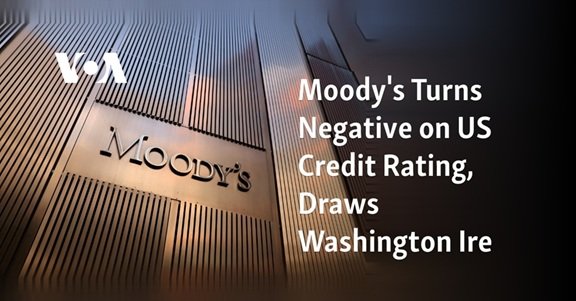
Moody’s Downgrade: A Wake-Up Call for America’s Economic Credibility
Posted in :
America’s downgrade from Moody’s isn’t just another headline—it’s a symptom of deeper issues in fiscal policy. With debt ballooning and investor nerves fraying, it’s time to face the hard questions about the nation’s economic future.
The recent downgrade of the US government’s credit rating by Moody’s has rattled both Wall Street and everyday investors, serving as an urgent signal about the country’s mounting debt, escalating borrowing costs, and questions over future fiscal stability. This post explores the roots, reactions, and ramifications of the downgrade – weaving in data, expert perspectives, and even a creative analogy or two to help make sense of these turbulent financial times.
Several years ago, a friend once joked: “America could max out every credit card in the world, and the banks would still beg it to open another.” Back then, it seemed like the nation’s status as a ‘safe haven’ was untouchable. Not anymore. On Monday morning, the financial world collectively grimaced at the news that Moody’s had downgraded the US government’s credit rating. It wasn’t trade wars, inflation, or interest rates making headlines – it was something altogether more fundamental: America’s credibility. As markets quivered, and politicians downplayed the crisis, the real question became, what happens when the world’s favorite borrower starts failing its own credit check?
From AAA to ‘Uh-Oh’: What Moody’s Downgrade Actually Signals
It was a gut punch from the markets. Not tariffs. Not inflation. Not even interest rates. This time, something more fundamental shook America’s economic foundation. Moody’s, the last of the big three credit agencies to hold out, finally pulled the plug on the United States’ perfect credit. The country’s coveted AAA status? Gone.
Who’s to Blame? The Political Blame Game Begins
The finger-pointing started almost immediately. Moody’s didn’t mince words. The downgrade wasn’t just about numbers on a spreadsheet. It was about years—decades, even—of political gridlock and fiscal mismanagement. Successive presidents, Congress, and a ballooning federal deficit all took their share of the blame. No one escaped unscathed.
It’s not just a technical downgrade. It’s a warning shot. The message: America’s creditworthiness is no longer untouchable. The world noticed.
Markets React: Wall Street’s Mood Turns Sour
The news broke late Friday, after markets closed. But the fallout was immediate and global. Before American markets even opened on Monday, the shockwaves had already hit Asia. U.S. equity futures dropped. The dollar slipped. Treasury yields shot higher.
The numbers tell the story:
- Moody’s dropped the U.S. credit score from AAA
- 10-year Treasury yield jumped to 4.5%
- 30-year yield climbed close to 5%—just shy of the 2023 high of 5.18%
Investors were nervous. Very nervous. The kind of nervous that makes people rethink their entire strategy overnight.
What’s a “Bear Steepener” and Why Should You Care?
Max Goldman from Franklin Templeton put it bluntly:
“We could be entering a dangerous cycle, what traders call a bear steepener. That’s when long-term yields rise faster than short-term ones. And it means that the government’s borrowing costs actually begin to soar.”
A bear steepener isn’t just market jargon. It’s a sign that investors are losing faith in the government’s ability to manage its finances. When long-term borrowing gets more expensive, it’s not just a headache for Washington. It’s a warning for everyone—from homeowners to businesses to retirees.
Conclusion: A Wake-Up Call, Not Just a Downgrade
Moody’s downgrade is more than a headline. It’s a wake-up call. The loss of AAA status signals deep-rooted issues—political stalemate, rising debt, and a growing sense of uncertainty about America’s economic future. Wall Street’s reaction was swift, but the real impact may take months, even years, to play out. The world is watching. And for now, the message is clear: America’s credit isn’t bulletproof anymore.
TL;DR: America’s downgrade from Moody’s isn’t just another headline—it’s a symptom of deeper issues in fiscal policy. With debt ballooning and investor nerves fraying, it’s time to face the hard questions about the nation’s economic future.
USTreasuryYields, FederalDeficitTrends, Moody’sRating, USEconomicOutlook, CongressionalBudgetOfficeDebt, WallStreetReactionDowngrade, USFiscalPolicy, USBorrowingCosts, ForeignInvestmentUSDebt, USCreditDowngrade,Moody’sdowngrade, U.S.creditrating, economiccredibility, AAratingloss, bearsteepener, politicalgridlock, nationaldebtcrisis, Treasuryyields, WallStreetreaction, creditworthiness
#USTreasuryYields, #FederalDeficitTrends, #CongressionalBudgetOfficeDebt, #USEconomicOutlook, #USBorrowingCosts, #ForeignInvestmentUSDebt, #USFiscalPolicy, #Moody’sRating, #WallStreetReactionDowngrade, #USCreditDowngrade,#moodysdowngrade, #uscreditrating, #economiccrisis, #nationaldebt, #politicalgridlock, #wallstreetreaction, #bearsteepener, #uscredibility, #treasuryyields, #financialmarkets

